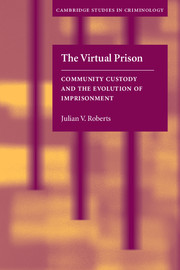Book contents
- Frontmatter
- Contents
- List of figures and tables
- Foreword by Andrew Ashworth
- Preface
- 1 Introduction to the concept of community custody
- 2 The way we punish now
- 3 Conceptualizing community custody
- 4 Representative models of community custody
- 5 Coming home to prison: offender perceptions and experiences
- 6 The effect of community custody on prison admissions
- 7 Public attitudes to community custody
- 8 Making community custody sentences work
- Notes
- References
- Index
3 - Conceptualizing community custody
Published online by Cambridge University Press: 07 December 2009
- Frontmatter
- Contents
- List of figures and tables
- Foreword by Andrew Ashworth
- Preface
- 1 Introduction to the concept of community custody
- 2 The way we punish now
- 3 Conceptualizing community custody
- 4 Representative models of community custody
- 5 Coming home to prison: offender perceptions and experiences
- 6 The effect of community custody on prison admissions
- 7 Public attitudes to community custody
- 8 Making community custody sentences work
- Notes
- References
- Index
Summary
I have been studying how I may compare
This prison where I live unto the world:
And for because the world is populous
And here is not a creature but myself,
I cannot do it …
The nature of community custody requires careful elucidation. Although community custody regimes vary widely, they share many common elements, and all differ in important ways from terms of imprisonment in a penal institution. This chapter compares and contrasts community custody and institutional imprisonment. Imprisonment is exclusionary, destructive and anathema to the sentencing objectives such as restoration and rehabilitation. In contrast, community custody is an inclusive sanction; although carrying a punitive element, it also encourages rehabilitation and restoration. Community custody is also an active disposition; offenders are encouraged to use their time, rather than simply pass it in a prison cell. Indeed, through the use of specific conditions, many community custody orders compel this kind of active participation in the sentence. The ‘virtual prison’ therefore has the potential to offer much more than its institutional counterpart. Comparisons between the two sanctions must also address the following question: to what extent can community confinement promote the traditional goals of sentencing? The response to this question must perforce be comparative rather than absolute in nature. For example, how much more (or less) effective than prison, or the alternative punishments, is community custody? In this chapter I therefore examine the relationship between community custody and some of the traditional purposes of sentencing.
- Type
- Chapter
- Information
- The Virtual PrisonCommunity Custody and the Evolution of Imprisonment, pp. 38 - 65Publisher: Cambridge University PressPrint publication year: 2004

